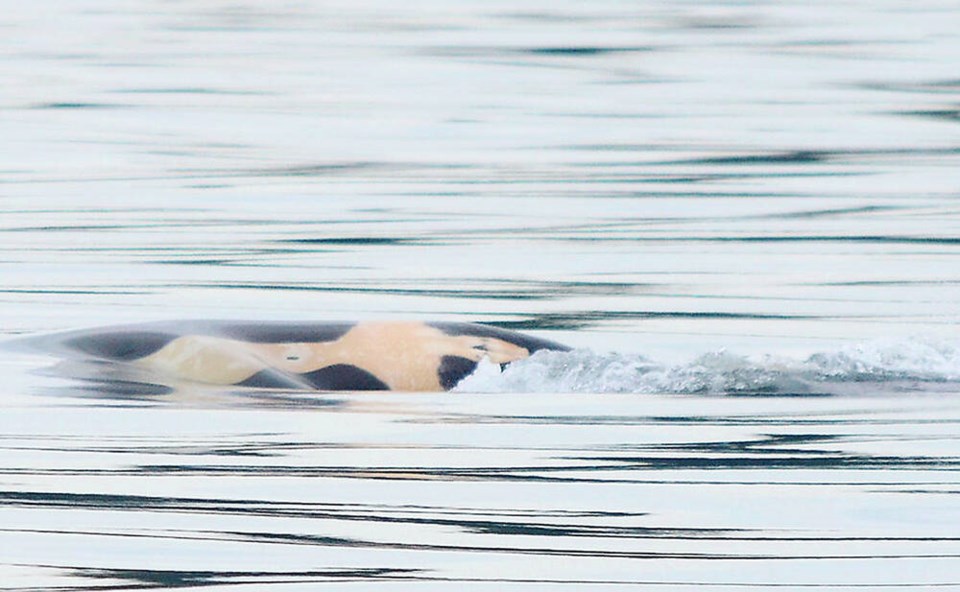The newest member of J-Pod is a girl, which is promising news for the future of endangered southern resident killer whales, say scientists.
J59, born in late February, was filmed by scientists using a drone on Thursday around the San Juan Islands as the young calf rolled on the surface and underwater with family members, exposing the ventral side and confirming the sex.
The Center for Whale Research, based in Friday Harbor, said the growth of the southern resident population is largely limited by the number of reproductively aged females. “While one calf won’t save the population, we hope that J59 can grow to adulthood and contribute to future generations of southern residents.”
All 25 members of J-Pod returned to the Salish Sea this week for only the second time during the month of May over the past five years. The orcas have been swimming in Haro Strait, the Strait of Georgia near the Fraser River and down into the San Juan Islands for the past four days, an indication of ample amounts of chinook salmon to eat.
Unlike their transient counterparts, which feed on seals and sea lions, southern resident pods only eat salmon, and prefer chinook.
J59 appears to be healthy and strong, said Monika Wieland-Shields, a scientists with the Orca Behaviour Institute, which is also based in Friday Harbor.
While any calf born to the southern residents is a cause for celebration, with the killer whale population as a whole tending to have more male calves, young females are “extra special,” Wieland-Shields said.
“We’ve seen a more even mix of males and females in J-Pod specifically, and that’s what we need if these whales have a chance at recovery. Young females are critical because we need that future reproductive potential.”
J-Pod now has 10 adult females — age 15 and over — and five juvenile females, including J59, as well as four adult males and six juvenile males, according to the Orca Behaviour Institute.
The southern resident group is down to 75 members, and includes L-Pod, the largest family line at 33 members, and K-pod with 17.
J-Pod, which spends more time than the others in the Salish Sea, captured hearts around the world in the summer of 2018 when J35 Tahlequah gave birth to a calf that died shortly after birth. The grieving mother carried its body on her rostrum for 17 days.
The group is composed of four matrilines, a societal system where all the orcas are descended from their mother’s line.
Donna Sandstrom, founder and executive director of The Whale Trail — a series of sites to view marine mammals from shore along the Pacific coast — said there is another possible factor contributing to the orcas’ return and foraging success in the Salish Sea. “For only the second year in recent history they are not followed by a flotilla of whale-watching vessels each time they return,” she said.
In 2020, Washington state adopted a licensing program for commercial whale-watching, with distancing rules of 300 yards to protect the southern residents. No whale-watching of the residents is allowed October through June, and very limited whale-watching is allowed July through September.
The Canadian government has adopted stronger rules, with required distancing of 400 metres, as well as no-fishing and orca sanctuary zones.
For the third consecutive year, the Department of Fisheries and Oceans said vessels must stay at least 400 metres from all killer whales in southern British Columbia coastal waters between Campbell River and Ucluelet, including Barkley and Howe Sound. The rule is in effect until May 31, 2023.
“When the southern residents return to the Salish Sea now it is quieter, and they have a better chance to forage, rest and tend their young,” said Sandstrom. “A sea change is underway, against great odds.”
Sandstrom said research is showing that controlling boat distances and speeds is helping the salmon and orca health.
A study last year by the U.S. National Oceanic and Atmospheric Administration showed boat traffic within 400 yards of southern resident orcas interrupts foraging, and often leads to females stopping feeding entirely.
It was a key finding for fisheries scientists, who had been watching surface behaviour in relation to vessel traffic. They adopted suction-cup tags that track the whales’ movement underwater during extended underwater dives.
Results published in Frontiers in Marine Science showed that nearby vessel traffic inhibits the orcas’ underwater foraging as much or more than what scientists previously documented at the surface.
“We found a bigger effect in females, and that effect was more often that they gave up foraging if vessels encroached on them,” said research scientist Marla Holt at NOAA Fisheries’ Northwest Fisheries Science Center.
The effect of vessel traffic on female whales “could have cascading effects on the ability to meet energetic requirements to support reproductive efforts,” the scientists reported. “This is particularly concerning in an endangered population that is in decline.”
The limited dive capacity of female whales and the more pronounced effects of vessels combine into a kind of “double whammy” for the females, Holt said. Vessel traffic may also disrupt prey sharing that can help sustain lactating females with calves that have greater energetic requirements.
Scientists believe boat noise interrupts the echolocation clicks orcas use to find prey, or they may even perceive vessels as a threat, Holt said, adding the effects may be most serious for pregnant or nursing mothers that must support calves.
Female orcas produce calves only every three to seven years, and reproduction is essential for the dwindling population to have any hope of recovery, said the U.S. study.



